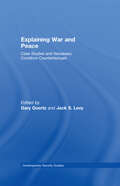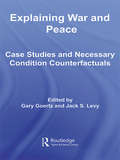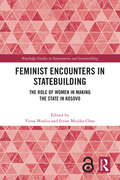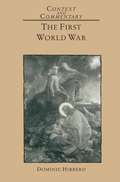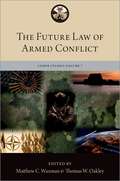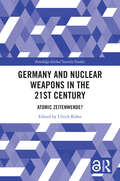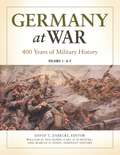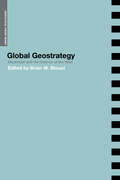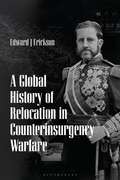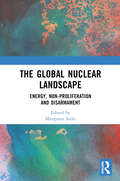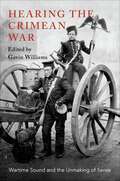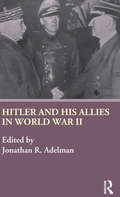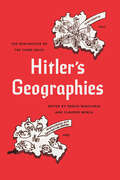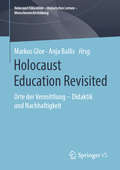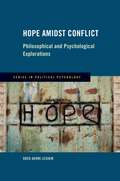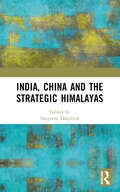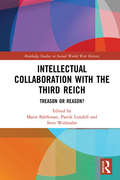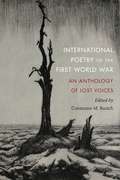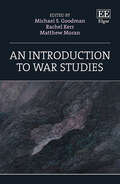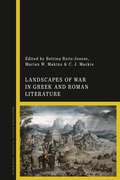- Table View
- List View
Explaining War and Peace: Case Studies and Necessary Condition Counterfactuals (Contemporary Security Studies)
This edited volume focuses on the use of ‘necessary condition counterfactuals’ in explaining two key events in twentieth century history, the origins of the First World War and the end of the Cold War. Containing essays by leading figures in the field, this book analyzes the causal logics of necessary and sufficient conditions, demonstrates the variety of different ways in which necessary condition counterfactuals are used to explain the causes of individual events, and identifies errors commonly made in applying this form of causal logic to individual events. It includes discussions of causal chains, contingency, critical junctures, and ‘powder keg’ explanations, and the role of necessary conditions in each. Explaining War and Peace will be of great interest to students of qualitative analysis, the First World War, the Cold War, international history and international relations theory in general.
Explaining War and Peace: Case Studies and Necessary Condition Counterfactuals (Contemporary Security Studies)
This edited volume focuses on the use of ‘necessary condition counterfactuals’ in explaining two key events in twentieth century history, the origins of the First World War and the end of the Cold War. Containing essays by leading figures in the field, this book analyzes the causal logics of necessary and sufficient conditions, demonstrates the variety of different ways in which necessary condition counterfactuals are used to explain the causes of individual events, and identifies errors commonly made in applying this form of causal logic to individual events. It includes discussions of causal chains, contingency, critical junctures, and ‘powder keg’ explanations, and the role of necessary conditions in each. Explaining War and Peace will be of great interest to students of qualitative analysis, the First World War, the Cold War, international history and international relations theory in general.
Feminist Encounters in Statebuilding: The Role of Women in Making the State in Kosovo (Routledge Studies in Intervention and Statebuilding)
This volume provides one of the first comprehensive feminist readings of international statebuilding, with a specific focus on the case of Kosovo.Rather than simply showing how the state in Kosovo is being built by and through women and feminist encounters, this volume is interested to problematise women and feminist subjectivities vis-à-vis the state and statebuilding. The book challenges three main arguments related to the processes and subjects of statebuilding in Kosovo. First, the academic literature on Kosovo has a tendency to take the international intervention of 1999 as the originary point of statebuilding processes in Kosovo. Second, and relatedly, given Kosovo's unprecedented exposure to Western intervention and statebuilding, the majority of works start from the presumption that liberal interventionism in Kosovo (and elsewhere) is normatively more progressive than the previous system, and that the liberal interventionism and statebuilding are naturally gender progressive and gender-equal. The third argument has to do with the existing legal architecture on gender and women’s rights in contemporary Kosovo. The aim of the volume is to, on the one hand, problematise the evidence against the backdrop of everyday manifestations and/or performances of statebuilding and on the other hand interrogate the co-constitutive gender aspect. In terms of methodology, the volume brings together contributions that rely on traditional and multi-sited ethnography, and narrative research rooted in projects and initiatives in Kosovo. This allows the contributors to unearth new and silenced actors, entry points, subjects and subjectivities in processes of and related to statebuilding in Kosovo; feminist frictions and challenges to statebuilding in Kosovo; as well as encounters of heteronormative statebuilding.This book will be of much interest to students of statebuilding, Balkan politics, feminisms, and international relations, in general.
The First World War (Context and Commentary)
The Great War was the first in British history to involve virtually the entire population of Britain. A vast quantity of poems, fiction, essays, speeches, letters, memoirs and other written material was produced during 1914 and 1918 and Hibberd chooses both famous passages and excerpts which have never before been reprinted, from both the imaginative poetry and prose of the period, and documents such as newspapers and politicians' speeches. The linking commentary illuminates the very close relationship between the literature and history of this time, which is further highlighted by the chronological table, plates section and further reading sections.
The Future Law of Armed Conflict (The Lieber Studies Series)
Warfare is changing - and rapidly. New technologies, new geopolitical alignments, new interests and vulnerabilities, and other developments are changing how, why, and by whom conflict will be waged. Just as militaries must plan ahead for an environment in which threats, alliances, capabilities, and even the domains in which they fight will differ from today, they must plan for international legal constraints that may differ, too. This volume considers how law and institutions for creating, interpreting, and enforcing it might look two decades ahead - as well as what opportunities may exist to influence it in that time. Such assessment is important as the U.S. and other governments plan for future warfare. It is also important as they formulate strategies for influencing the development of law to better serve security, humanitarian, and other interests. This volume examines not just specific questions, such as how might a particular technology require adaptive interpretation of existing law, but also grand ones, such as whether law is capable at all of keeping up with these changes.
Germany and Nuclear Weapons in the 21st Century: Atomic Zeitenwende? (Routledge Global Security Studies)
This book is the first scholarly book to take a comprehensive look at Germany’s nuclear weapons policies in the 21st century.German foreign and security policy is facing a profound reorientation. Great power competition between the United States and both a revanchist Russia and a rising China, the return of war and nuclear threats to Europe, and the emergence of new technologies all force Germany to adapt. German policymakers and scholars increasingly speak of a pivotal Zeitenwende, an epochal turning point in history. How does Germany adapt its nuclear policies to these changing conditions?The volume brings together internationally renowned nuclear scholars and policy analysts from Germany and abroad. Focussing on German nuclear deterrence, arms control and disarmament as well as nonproliferation policies, the contributors assess how German leaders have navigated continuity and change, domestically and abroad. The volume concludes that Germany remains bound by dependence on the United States and its own conservatism. Within these parameters, German leaders have adapted slowly to change and continue to balance seemingly contradictory deterrence and disarmament goals.This book will be of much interest to students of nuclear proliferation, security studies, German politics and International Relations, as well as policymakers.
Germany at War [4 volumes]: 400 Years of Military History [4 volumes]
Written by experts for use by nonexperts, this monumental work probes Germany's "Genius for War" and the unmistakable pattern of tactical and operational innovation and excellence evident throughout the nation's military history.Despite having the best military forces in the world, some of the most advanced weapons available, and unparalleled tactical proficiency, Germany still lost both World Wars. This landmark, four-volume encyclopedia explores how and why that happened, at the same time examining Germany as a military power from the start of the Thirty Years' War in 1618 to the present day. Coverage includes the Federal Republic of Germany, its predecessor states, and the kingdoms and principalities that combined to form Imperial Germany in 1871.The Seven Years' War is discussed, as are the Napoleonic Wars, the Wars of German Unification (including the Franco-Prussian War), World War I, World War II, and the Cold War. In all, more than 1,000 entries illuminate battles, organizations, leaders, armies, weapons, and other aspects of war and military life. The most comprehensive overview of German military history ever to appear in English, this work will enable students and others interested in military history to better understand the sociopolitical history of Germany, the complex role conflict has played in the nation throughout its history, and why Germany continues to be an important player on the European continent.
Global Geostrategy: Mackinder and the Defence of the West
This is a new examination of Halford Mackinder’s seminal global geostrategic work, from the perspective of geography, diplomatic history, political science, international relations, imperial history, and the space age.Mackinder was a man ahead of his time. He foresaw many of the key strategic issues that came to dominate the twentieth century. Until the disintegration of the Soviet Union, western defence strategists feared that one power, or alliance, might come to dominate Eurasia. Admiral Mahan discussed this issue in The Problem of Asia (1900) but Mackinder made the most authoritative statement in "The Geographical Pivot of History" (1904). He argued that in the "closed Heart-Land of Euroasia" was a strategically placed region, with great resources, that if controlled by one force could be the basis of a World Empire. James Kurth, in Foreign Affairs, has commented that it has taken two World Wars and the Cold War to prevent Mackinder’s prophecy becoming reality. In World War I and World War II Germany achieved huge territorial gains at the expense of the Russian empire and the Soviet Union. In the former conflict the Russian empire was defeated by Germany but the western powers insisted that the territorial gains made by Germany, at the treaty of Brest-Litovsk, be given up. In World War II Britain and the US gave material support to Stalin’s totalitarian regime to prevent Nazi Germany gaining control of the territory and resources that might have been a basis for world domination. The west, highly conscious of Mackinder’s dictum (1919) that "Who rules East Europe commands the Heartland," quickly adopted policies to contain the Soviet Union. History has therefore proved Mackinder’s work to be of vital importance to generations of strategic thinking and he remains a key influence in the new millennium.This book will be of great interest to all students and scholars of strategic studies and military history and of geopolitics in particular.
A Global History of Relocation in Counterinsurgency Warfare
Relocation as a strategy and operational approach in war has reappeared in various forms from the late 18th century to the present day. In A Global History of Relocation in Counterinsurgency Warfare, Edward J Erickson brings together a distinguished cast of contributors to present a chronological survey of the major relocations of people conducted as deliberate operational approaches to modern conflicts.Each chapter covers a different case study, including the removal of Native Americans in the USA, La Reconcentracion in Cuba, the American internment of Filipinos after the Balangiga Massacre, the deportation of the Boer population in South Africa and the relocation of Ottoman Armenians and Russian Jews. Bringing together the threads of the separate case studies, the conclusion reaffirms relocation as a deliberate operational approach used by major powers in warfare against real or perceived threats. This is a vital volume for academics and students interested in military history, counterinsurgency and strategic studies.
The Global Nuclear Landscape: Energy, Non-proliferation and Disarmament
Like shifting sands of a desert, the global nuclear landscape changes every few years across its three main constituents - nuclear energy, non-proliferation and disarmament. Each of these has seen phases of cautious optimism, deep scepticism and outright pessimism over the last two decades. This book offers a bird’s eye view on all the three, even as the individual authors offer a worm’s eye view on each specific topic within the larger ambit. The first section of the book examines developments in the nuclear energy sector. A broad-brush scan of the contemporary drivers and challenges for nuclear energy at a global level, as also that of India, reveals a positive trend line. There is also cautious optimism around the concept, developments and prospects of small modular reactors. It remains to be seen how effectively and quikcly licensing and regulation issues are resolved for the new concepts to become commericially viable. The second part of the book is devoted to non-proliferation. Vertical nucluear and missile proliferation amongst nuclear armed states, and horizontal proliferation cases of Iran and possibilities in East Asia are considered. Nuclear terrorism and the state of the NPT are also examined. Collectively, these issues reflect a mood of pessimism on non-proliferation at this juncture. Neither is there much to cheer on nuclear disarmament. The last section of the book examines the consequences of use of nuclear weapons, concepts of CBMs and arms control, and recent disarmament initiatives. A tentative exploration of the prospects of disarmament in the wake of Russia-Ukraine conflict is also undertaken. A hope that good sense will prevail, and fear that it might not, seem to coexist at this moment. It is in India's interest to proactively shape the landscape across these three elements. The book seeks to provide the basis to do so.
Hearing the Crimean War: Wartime Sound and the Unmaking of Sense
What does sound, whether preserved or lost, tell us about nineteenth-century wartime? Hearing the Crimean War: Wartime Sound and the Unmaking of Sense pursues this question through the many territories affected by the Crimean War, including Britain, France, Turkey, Russia, Italy, Poland, Latvia, Dagestan, Chechnya, and Crimea. Examining the experience of listeners and the politics of archiving sound, it reveals the close interplay between nineteenth-century geographies of empire and the media through which wartime sounds became audible--or failed to do so. The volume explores the dynamics of sound both in violent encounters on the battlefield and in the experience of listeners far-removed from theaters of war, each essay interrogating the Crimean War's sonic archive in order to address a broad set of issues in musicology, ethnomusicology, literary studies, the history of the senses and sound studies.
Hitler and His Allies in World War Two
In an area where in-depth studies of Hitler's relations with Nazi Germany's allies, and the failure of Nazi Germany to make more effective use of them during the war, are scant, this is a survey that looks at the Soviet Union, Japan, France, Italy, Spain, Romania and Hungary and their relationship to Nazi Germany. Using a comparative approach, seven case studies examine themes such as co-operation and resistance, military and economic aid, treatment of Jews, relations with the enemies and the popular sentiment towards Germany. Jonathan Adelman has provided students of the Second World War with a welcome mine of information and a unique perspective on a much-studied topic.
Hitler's Geographies: The Spatialities of the Third Reich
Lebensraum: the entitlement of “legitimate” Germans to living space. Entfernung: the expulsion of “undesirables” to create empty space for German resettlement. During his thirteen years leading Germany, Hitler developed and made use of a number of powerful geostrategical concepts such as these in order to justify his imperialist expansion, exploitation, and genocide. As his twisted manifestation of spatial theory grew in Nazi ideology, it created a new and violent relationship between people and space in Germany and beyond. With Hitler’s Geographies, editors Paolo Giaccaria and Claudio Minca examine the variety of ways in which spatial theory evolved and was translated into real-world action under the Third Reich. They have gathered an outstanding collection by leading scholars, presenting key concepts and figures as well exploring the undeniable link between biopolitical power and spatial expansion and exclusion.
Holocaust Education Revisited: Orte der Vermittlung – Didaktik und Nachhaltigkeit (Holocaust Education – Historisches Lernen – Menschenrechtsbildung)
Der Band befasst sich mit pädagogischen Konzepten der Holocaust Education, die aufgrund gesellschaftlicher Veränderungen einem Wandel unterworfen sind. Historische Orte werden um- und neu gestaltet sowie Geschichte an die Medienvorlieben der Lernenden angepasst. Solchermaßen soll eine nachhaltige Auseinandersetzung mit dem Themenfeld Holocaust und NS-Verbrechen initiiert werden. Im 21. Jahrhundert sind die Fragen nach dem Warum, Wie und Wo von Holocaust Education neu zu stellen und vorliegender Band bietet Antworten darauf.
Hope Amidst Conflict: Philosophical and Psychological Explorations (Series in Political Psychology)
How does hope for peace form and proliferate in the seemingly hopeless reality of conflict, and why do despair and fear often prevail? How do political elites utilize hope and skepticism to manipulate their public during conflict? And how does hope manifest itself at the societal level? Hope Amidst Conflict takes on the bold challenge of answering these questions by merging insights from philosophy and social psychology and investigating hope for peace in an intense political context--the intractable, violent conflict between Israel and the Palestinians. Hope for peace has gathered scholarly attention in the last decade. However, the work has been focusing on the mechanisms of hope while failing to ask the bigger questions about hope's role in the politics of conflict. Moreover, existing research presents a confusing account of what hope "is" and how it can be measured. This confusion yielded mixed results regarding the levels and consequences of hope during conflict. Combining the wisdom of more than a hundred years of scholarship on hope with insights from original data collected in conflict zones, Hope Amidst Conflict offers a novel conceptualization of hope and a standardized way to measure hope in a wide array of contexts. Using these new approaches, the book embarks on a journey to identify the determinants and consequences of hope amidst conflict.
India, China and the Strategic Himalayas
This book analyses strategic discourse on the Himalayas from the perspective of India’s interests. Home to many communities, cultures, natural resources and political boundaries, it is the geopolitical landscape of the Himalayas between India and China that dominates other narratives and discourses. The traditional notion of Himalayas as India’s frontiers and buffer is challenged by China. Despite various mechanisms to address border resolution there are violations and transgressions from China. This book examines India’s responses to the new emerging challenges in the Himalayas. How the statist discourse on strategic interests incorporates people’s discourse. It provides a nuanced understanding of India’s strategic undertakings, diplomatic initiatives and development framework. This book will be a valuable addition to existing knowledge on the Himalayas between India and China. Scholars and practitioners interested in International Relations, Strategic Studies, Himalayan Studies and South Asian Studies will find it useful. Print edition not for sale in South Asia (India, Sri Lanka, Nepal, Bangladesh, Pakistan and Bhutan)
Intellectual Collaboration with the Third Reich: Treason or Reason? (Routledge Studies in Second World War History)
The book investigates the rather neglected "intellectual" collaboration between National Socialist Germany and other countries, including views on knowledge and politics among "pro-German" intellectuals, using a comparative approach. These moves were shaped by the Nazi system, which viewed scientific and cultural exchange as part and parcel of their cultural propaganda and policy. Positive views of the Hitler regime among intellectuals of all sorts were indicative of a broader discontent with democracy that, among other things, represented an alternative approach to modernization which was not limited to the German heartlands. This book draws together international experts in an analysis of right-wing Europe under Hitler; a study which has gained new resonance amidst the wave of European nationalism in the twenty-first century.
Internal combustion engine - Multipage image (Large Print)
These diagrams of an internal combustion engine are on two pages with two diagrams per page, separated by a vertical dotted line. There is a locator dot shown, which will be at the top left of the page when the image is the right way up. Each diagram is titled in the top left and shows a phase of the combustion engine cycle. In the top of each diagram from left to right there is an intake valve, a spark plug and an exhaust valve. In the centre of the image is the cylinder with the piston in its middle. This has a water cooling jacket to the left and right. The piston is connected by a connecting rod to the crankshaft and axle at the bottom of the image. Not all elements are labelled on every diagram. The valves and crankshaft are also in different positions. The crankshaft is continuously turning clockwise (with the top moving to the right) throughout all stages. In the first diagram fuel is being drawn into the cylinder through the open intake valve as the piston moves down. In the second diagram the intake valve has closed, the piston moves up and the air and fuel mixture is squashed. In the third diagram the air and fuel mixture has been ignited by a spark from the spark plug. The mixture burns and expands rapidly driving the piston down. In the last diagram the exhaust valve is open and the piston moves up driving the exhaust out of the cylinder. There are usually at least two cylinders which comprise the whole engine. They all drive the same crankshaft but are phased so that, for example, while one cylinder will be sucking air and fuel in, another will be burning the compressed mixture and generating the power.
Internal combustion engine - Multipage image (UEB Contracted)
These diagrams of an internal combustion engine are on two pages with two diagrams per page, separated by a vertical dotted line. There is a locator dot shown, which will be at the top left of the page when the image is the right way up. Each diagram is titled in the top left and shows a phase of the combustion engine cycle. In the top of each diagram from left to right there is an intake valve, a spark plug and an exhaust valve. In the centre of the image is the cylinder with the piston in its middle. This has a water cooling jacket to the left and right. The piston is connected by a connecting rod to the crankshaft and axle at the bottom of the image. Not all elements are labelled on every diagram. The valves and crankshaft are also in different positions. The crankshaft is continuously turning clockwise (with the top moving to the right) throughout all stages. In the first diagram fuel is being drawn into the cylinder through the open intake valve as the piston moves down. In the second diagram the intake valve has closed, the piston moves up and the air and fuel mixture is squashed. In the third diagram the air and fuel mixture has been ignited by a spark from the spark plug. The mixture burns and expands rapidly driving the piston down. In the last diagram the exhaust valve is open and the piston moves up driving the exhaust out of the cylinder. There are usually at least two cylinders which comprise the whole engine. They all drive the same crankshaft but are phased so that, for example, while one cylinder will be sucking air and fuel in, another will be burning the compressed mixture and generating the power.
Internal combustion engine - Multipage image (UEB Uncontracted)
These diagrams of an internal combustion engine are on two pages with two diagrams per page, separated by a vertical dotted line. There is a locator dot shown, which will be at the top left of the page when the image is the right way up. Each diagram is titled in the top left and shows a phase of the combustion engine cycle. In the top of each diagram from left to right there is an intake valve, a spark plug and an exhaust valve. In the centre of the image is the cylinder with the piston in its middle. This has a water cooling jacket to the left and right. The piston is connected by a connecting rod to the crankshaft and axle at the bottom of the image. Not all elements are labelled on every diagram. The valves and crankshaft are also in different positions. The crankshaft is continuously turning clockwise (with the top moving to the right) throughout all stages. In the first diagram fuel is being drawn into the cylinder through the open intake valve as the piston moves down. In the second diagram the intake valve has closed, the piston moves up and the air and fuel mixture is squashed. In the third diagram the air and fuel mixture has been ignited by a spark from the spark plug. The mixture burns and expands rapidly driving the piston down. In the last diagram the exhaust valve is open and the piston moves up driving the exhaust out of the cylinder. There are usually at least two cylinders which comprise the whole engine. They all drive the same crankshaft but are phased so that, for example, while one cylinder will be sucking air and fuel in, another will be burning the compressed mixture and generating the power.
International Poetry of the First World War: An Anthology of Lost Voices
Ranging far beyond the traditional canon, this ground-breaking anthology casts a vivid new light on poetic responses to the First World War. Bringing together poems by soldiers and non-combatants, patriots and dissenters, and from all sides of the conflict across the world, International Poetry of the First World War reveals the crucial public role that poetry played in shaping responses to and the legacies of the conflict. Across over 150 poems, this anthology explores such topics as the following: · Life at the Front · Psychological trauma · Noncombatants and the home front · Rationalising the war · Remembering the dead · Peace and the aftermath of the war With contextual notes throughout, the book includes poems written by authors from America, Australia, Austria-Hungary, Belgium, Canada, France, Germany, Great Britain, India, Ireland, Italy, New Zealand, Russia, and South Africa.
An Introduction to War Studies
Commemorating 60 years of War Studies at King’s College London, this incisive and adroitly crafted book acts as a comprehensive introduction to the multidisciplinary field of war, conflict and security. Adopting a global approach, it adeptly navigates a broad spectrum of themes and theoretical perspectives which lie at the heart of this important area of study.Bringing together contributions from an array of esteemed scholars, An Introduction to War Studies covers a diverse range of topics, including international relations theories and approaches, conflict, security and development, peace and security, intelligence and international security, the history of war, conflict resolution, strategic communication, and terrorism and society. Providing concise and thematic focus, expert contributors survey the current state of knowledge within the field and explore opportunities for future scholarly inquiry.An authoritative and seminal contribution to the study of war and conflict, this book will be essential for academics, researchers, and students of war, peace and conflict, terrorism and security, and strategic studies as well as international relations and international studies.
Jet Turbine engine cross section (UEB Contracted)
In these diagrams of a jet engine, there is a cross section view through the length of the engine at the top of the page and in the bottom right of the page, a front view of the engine intake. There is a locator dot shown, which will be at the top left of the page when the image is the right way up. On the left of the page air is forced into the engine by the compressor which has many fan blades. The compressed air is fed into the combustion chamber in the middle of the page. Fuel is injected into the engine through a port in the lower centre part of the combustion chamber. This is where combustion and gas expansion takes place. On the right of the page the exhaust exits past the turbine producing the thrust of the engine. The front view shows the circular opening of the engine with lots of fan blades arranged around the central hub like a huge fan.
Jet Turbine engine cross section (UEB Uncontracted)
In these diagrams of a jet engine, there is a cross section view through the length of the engine at the top of the page and in the bottom right of the page, a front view of the engine intake. There is a locator dot shown, which will be at the top left of the page when the image is the right way up. On the left of the page air is forced into the engine by the compressor which has many fan blades. The compressed air is fed into the combustion chamber in the middle of the page. Fuel is injected into the engine through a port in the lower centre part of the combustion chamber. This is where combustion and gas expansion takes place. On the right of the page the exhaust exits past the turbine producing the thrust of the engine. The front view shows the circular opening of the engine with lots of fan blades arranged around the central hub like a huge fan.
Landscapes of War in Greek and Roman Literature
In this volume, literary scholars and ancient historians from across the globe investigate the creation, manipulation and representation of ancient war landscapes in literature. Landscape can spark armed conflict, dictate its progress and influence the affective experience of its participants. At the same time, warfare transforms landscapes, both physically and in the way in which they are later perceived and experienced. Landscapes of War in Greek and Roman Literature breaks new ground in exploring Greco-Roman literary responses to this complex interrelationship. Drawing on current ideas in cognitive theory, memory studies, ecocriticism and other fields, its individual chapters engage with such questions as: how did the Greeks and Romans represent the effects of war on the natural world? What distinctions did they see between spaces of war and other landscapes? How did they encode different experiences of war in literary representations of landscape? How was memory tied to landscape in wartime or its aftermath? And in what ways did ancient war landscapes shape modern experiences and representations of war? In four sections, contributors explore combatants' perception and experience of war landscapes, the relationship between war and the natural world, symbolic and actual forms of territorial control in a military context, and war landscapes as spaces of memory. Several contributions focus especially on modern intersections of war, landscape and the classical past.
